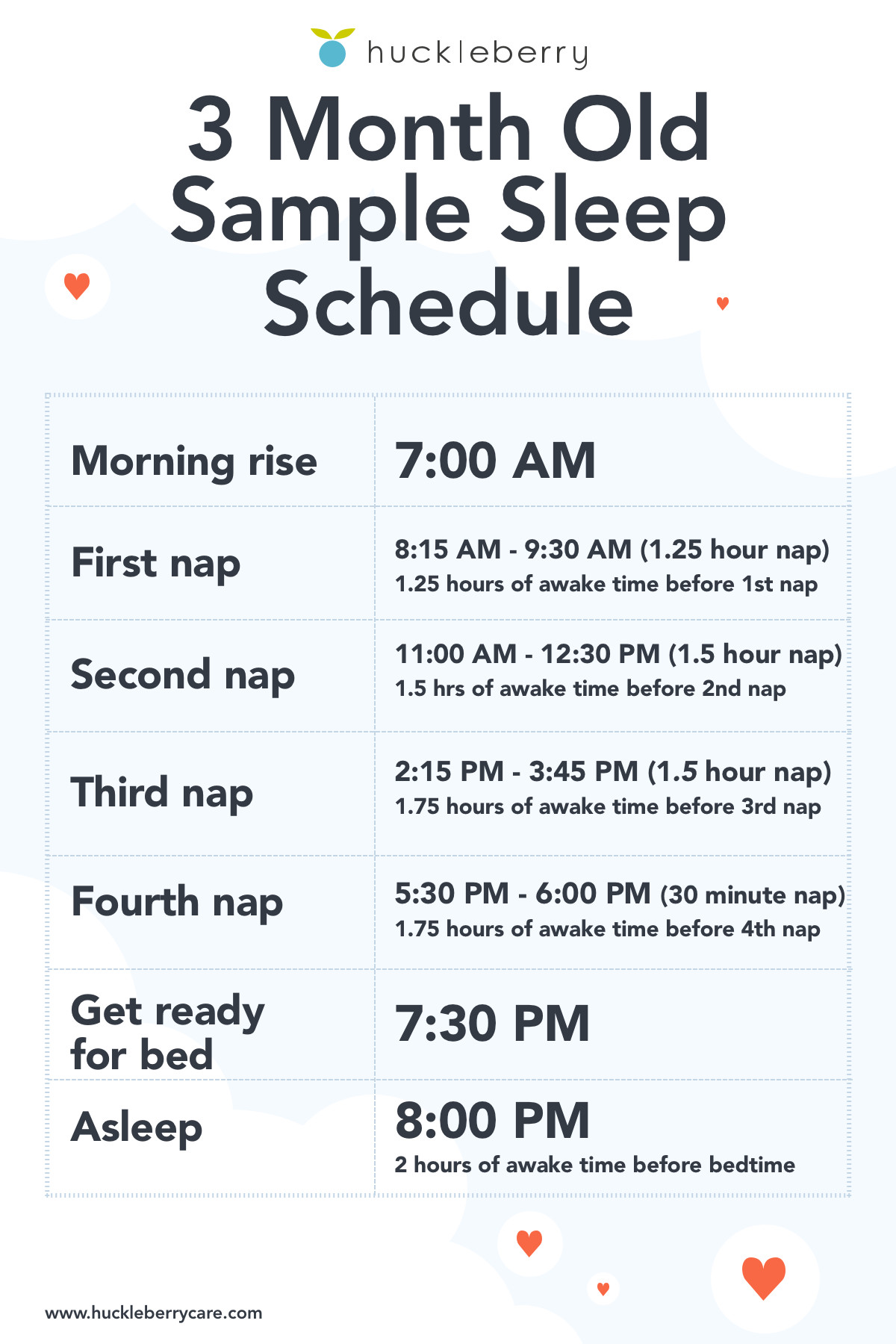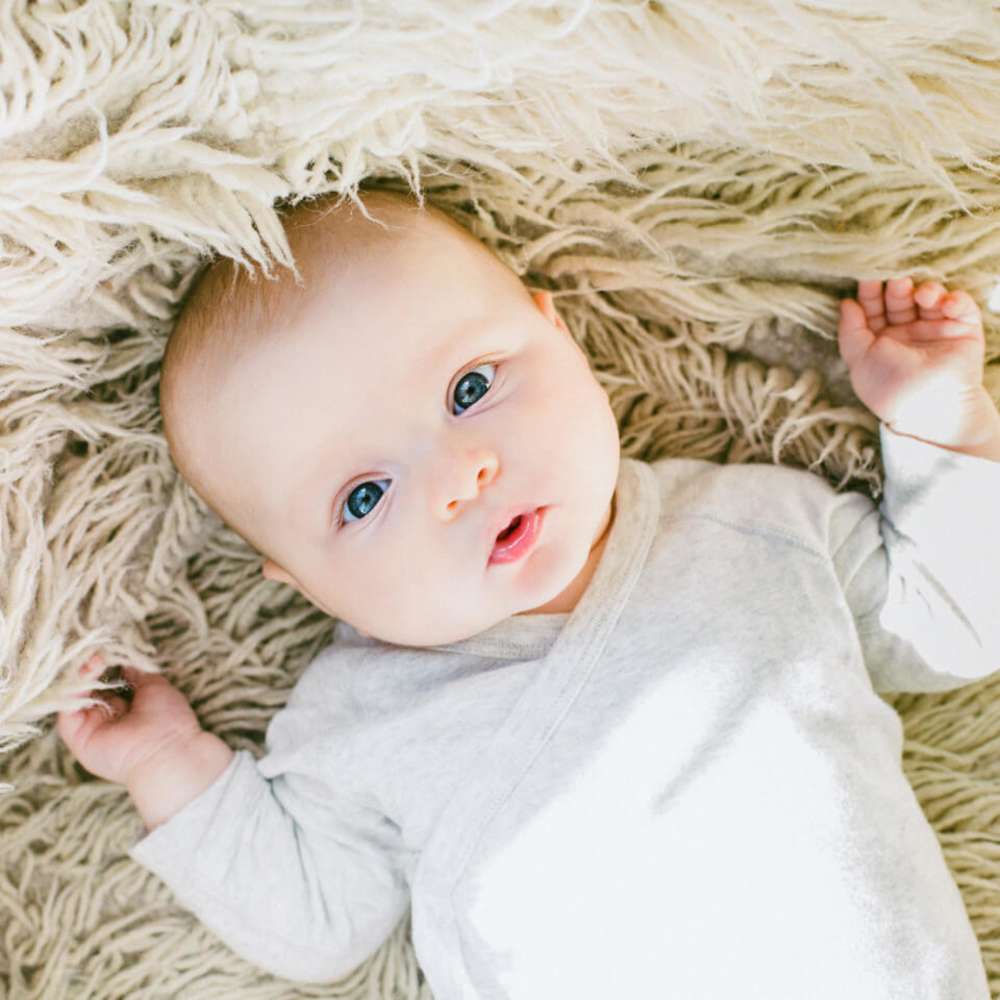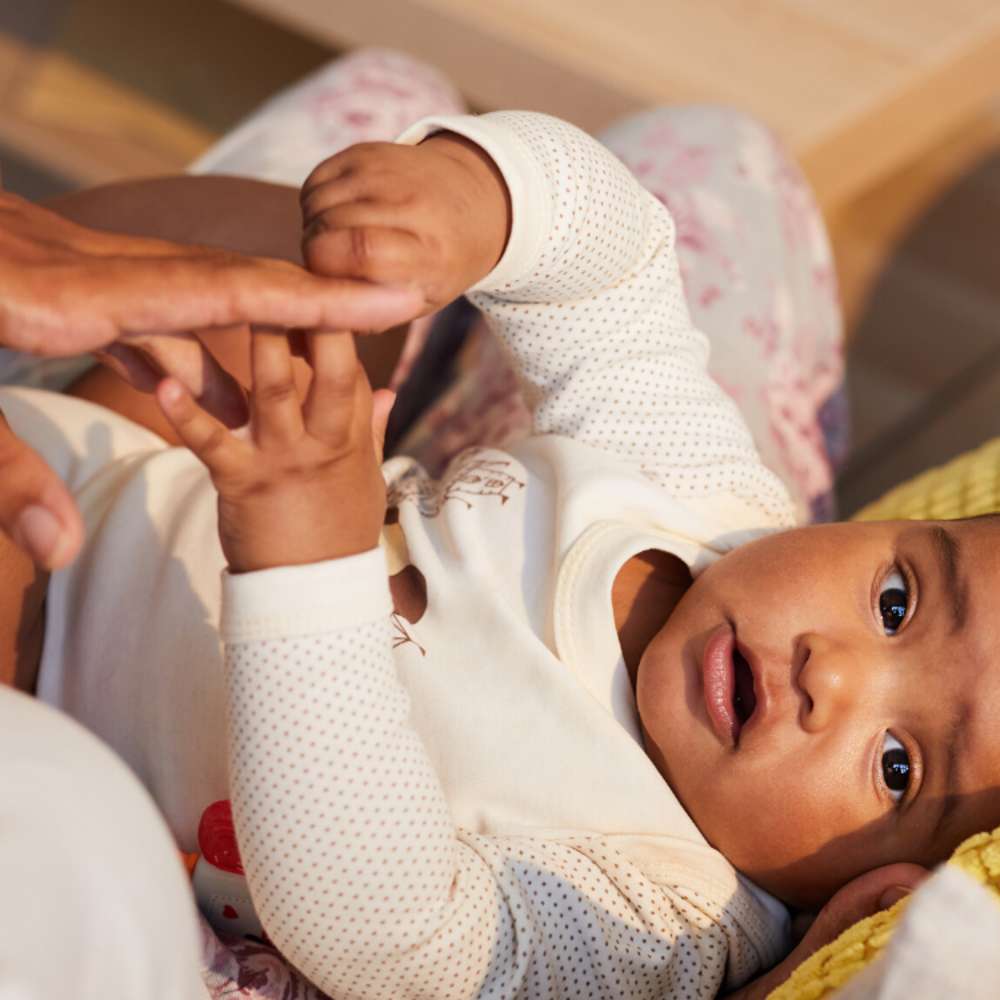3 month old sleep schedule: Bedtime and nap schedule

While your baby is outgrowing newborn diapers and clothes, they’re also growing out of their newborn sleep patterns. Between 3 and 4 months, you may notice some big differences in your baby’s sleep, like increased night waking and shorter naps [1].
Thank the circadian rhythm (a.k.a. your internal clock) for this change; it’s undergoing a maturation process that results in additional sleep cycles for your baby, and that often translates to disrupted sleep. Don’t fret — following the right schedule can improve sleep!
IN THIS ARTICLE:
How much should a 3 month old sleep?
Sample 3 month old sleep schedule
Naptime schedule for a 3 month old
How much should a 3 month old sleep?
At this age [2], most babies need about 15 hours of total sleep in a 24-hour period. Keep in mind that the amount of sleep needed can differ among babies and there is a range of what is considered normal and healthy. The suggested hours can serve as a general guide, but it's also important to pay attention to your child's mood and energy levels.
Ideally, we’ll see at least 10 hours of sleep at night and 3 - 5 naps a day, though there’s still a lot of variation at this age. Getting enough sleep remains an important part of a baby’s development.
[Note: for children who were born early, we go by their adjusted age for sleep development.]
Why is my 3 month old sleeping a lot?
It's common for young babies to sleep a lot and there is a range of sleep needs, with some babies needing more rest than others. As your little one gets a bit older, we'd expect them to be able to stay awake for longer periods of time in between naps. While babies typically need more sleep during an illness, please contact your pediatrician if you have any concerns about your infant being lethargic or sleeping a lot more than usual.
Sample 3 month old sleep schedule

Note: Sleep needs vary by child, and this chart should be viewed as an example.
Naptime schedule for a 3 month old

How long should a 3 month old nap?
Ideally, your 3 month old will get an average of 4 - 5 hours of daytime sleep, broken up into 3 - 5 naps. Short naps are still developmentally appropriate at this age, so it’s common to see 30 - 45 minute naps, as well as longer 1 - 2 hour naps.
How many daily naps are expected for a 3 month old?
Most 3 month olds take 4 - 5 naps per day. If your baby regularly takes longer naps, their wake windows will likely be longer, meaning they may be comfortable with just 4 naps a day. On the other hand, if your baby only has a bunch of short catnaps all day, they could require 5 naps to comfortably make it to bedtime.
At this age, we expect babies to need a nap after 60 - 120 minutes of awake time. Continue to pay attention to your baby’s sleep cues (getting quiet/still, staring off into space, putting their head down on you) and the amount of awake time to determine the best time to nap. You can also use Huckleberry’s SweetSpot to take the guesswork out of optimal sleep times.
Check out these sample schedules, keeping in mind they’re just that — samples. Your baby’s day may look quite different, which is expected and okay!
4-nap schedule


| Morning rise | 7:00 AM |
| 1st nap | 8:15 AM - 9:30 AM (1.25 hour nap); 1.25 hours of awake time before 1st nap |
| 2nd nap | 11:00 AM - 12:30 PM (1.5 hour nap); 1.5 hours of awake time before 2nd nap |
| 3rd nap | 2:15 PM - 3:45 (1.5 hour nap); 1.75 hours of awake time before 3rd nap |
| 4th nap | 5:30 PM - 6:00 (30 minute nap); 1.75 hours of awake time before 4th nap |
| Get ready for bed | 7:30 PM |
| Asleep | 8:00 PM; 2 hours of awake time before bed |
5-nap schedule


| 1st nap | 8:15 AM - 9:15 AM (1 hour nap); 1.25 hours of awake time before 1st nap |
| 2nd nap | 10:45 AM - 11:45 AM (1 hour nap); 1.5 hours of awake time before 2nd nap |
| 3rd nap | 1:15 PM - 2:15 PM (1 hour nap); 1.5 hours of awake time before 3rd nap |
| 4th nap | 3:45 PM - 4:45 PM (1 hour nap); 1.5 hours of awake time before 4th nap |
| 5th nap | 6:15 PM - 6:45 PM (30 minute nap); 1.5 hours of awake time before 5th nap |
| Get ready for bed | 8:00 PM |
| Asleep | 8:30 PM; 1.75 hours of awake time before bedtime |
Top sleep tip for 3 month olds
Here are some sleep tips to keep in mind for your 3 month old:
Introduce a comfort object [3] (or “lovey”) at this age. Even though we don’t recommend taking it into their sleep space with them yet (for safety reasons) [4], you can use it during pre-sleep routines so your baby can start developing an attachment to it.
Remember that daytime naps are important! Babies this age typically need a nap after 60 - 120 minutes of awake time.
Stay flexible. While a more structured routine is on the horizon, it’s normal for babies this age to have varying schedules.
Pay attention to sleep cues. Instead of trying schedule naps, keep an eye out for signs your baby is tired during the day. They may get quiet or still, stare off into space, or lay their head down on you.
It may be too early for sleep training. While it’s okay to start sleep training at 3 months, it’s important to keep realistic expectations. Many babies this young still need a little help falling asleep! You can try gentle methods like gradual withdrawal or pick-up-put-down, but always consider your baby’s health and specific sleep issues before starting.
Sleep fact for 3 month old babies
Although many parents are ready for more predictability at this age, most babies still need naps based on how long they’ve been awake for (otherwise known as wake windows), rather than set times “by the clock.”
Bedtime for a 3 month old
What time should a 3 month old go to bed?
At this age, we start to see bedtimes shift earlier. The ideal bedtime for a 3 month old tends to be 12 - 14 hours after waking for the day but no earlier than 6:00 PM. That means an optimal bedtime for a baby waking around 6:00 AM will be between 6:00 PM and 8:00 PM.
Bedtime will still depend on how many naps your baby takes and how long they can comfortably stay awake. Most 3 month olds have a wake window range that’s between 1 and 2 hours long. Babies taking fewer naps (3 - 4 per day) will generally need an earlier bedtime than babies taking 5 naps a day.
How long should a 3 month old sleep at night?
Typically, 3 month olds need between 10 - 12 hours of sleep at night, in addition to 4 - 5 hours of day sleep. At this age, it’s normal for babies to wake at night and need your help to fall back to sleep — whether it’s after a feeding or a quick cuddle.
Takeaway
Sleep requirements: Most 3 month olds need about 15 hours of total sleep, with variations among babies. Ideally, aim for 10 hours of sleep at night and 3 - 5 naps a day.
Naptime insights: A 3 month old ideally gets 4 - 5 hours of daytime sleep with 3 - 5 naps. Short naps are normal, and the number of naps depends on the length of individual naps.
Top sleep tip: Introduce a comfort object at this age during pre-sleep routines to help your baby develop attachment.
Bedtime transition: Bedtimes shift earlier around 3 months, typically 12 - 14 hours after waking for the day but not earlier than 6:00 PM. The bedtime depends on the number of naps and wake window duration.
Navigating these changes can be challenging, but with a thoughtful approach to sleep schedules, you can support your baby's evolving sleep patterns and contribute to their overall well-being.
If you're curious about what lies ahead in the coming month, glimpse into the future to see what you might experience once your baby is 4 months old.
3 month old baby sleep FAQ
Q: Can a 3 month old baby sleep through the night?
A:
The greatest changes in infants’ sleep patterns occur in the first 4 months of life [5]. Most babies this age will continue to wake during the night for feedings. Consult with your pediatrician and/or your lactation consultant if you have questions regarding the appropriate amount of feedings per night for your three month old.
Q: How often do 3 month old babies sleep?
A:
Typically, most babies this age have a wake window of 60 - 120 minutes, meaning they may need to sleep after just an hour of awake time. Aim for at least 15 hours of sleep during a 24-hour period (between 3 and 5 naps a day).
Q: How much nighttime sleep is expected for for a 3 month old?
A:
Target 10 - 12 hours of nighttime sleep, but remember that will likely still include waking for feedings.
Q: How much awake time does a 3 month old need?
A:
The majority of 3 month olds need sleep after an awake period of 60 - 120 minutes, depending on the time of day. The amount of awake time tends to be shorter in the morning and lengthens throughout the day. The last wake window is usually the longest stretch of awake time during the day, which means your baby will probably sleep best with 90 - 120 minutes of awake time in between the last nap and bedtime.
Q: How much daytime sleep is expected for a 3 month old?
A:
Your infant’s sleep habits will still be a bit unpredictable at this age. Aim for 4 - 5 hours of daytime sleep over the course of 4 - 5 naps.
Q: My 3 month old’s sleep is all over the place. How do I get a more predictable schedule?
A:
If you’d like to work on regulating your baby’s schedule, the best thing you can do is to aim for a consistent morning wake-up time. Ideally, the morning wake time will be within the same 30-minute window each morning. If your baby sometimes wakes at 6:00 AM and other times sleeps in until 8:00 AM, you might feel momentary tears of joy on those later mornings! However, the variation in the waking time can lead to a lot of unpredictability later on in the day when it comes to planning naps and bedtime.
Q: My 3 month old’s sleep is suddenly different. Is there a 3 month sleep regression?
A:
Between 3 and 4 months of age, your baby’s circadian rhythm [6] will mature, resulting in a change in the stages and cycles of sleep (they’ll no longer sleep like a newborn and instead have patterns similar to an adult). This is often referred to as the “4 month sleep regression.” You can read more about pediatric sleep patterns and the 4 month sleep regression here.
Q: When calculating sleep totals for my baby, should I subtract the time spent on night feeds?
A:
When we talk about the total amount of night sleep, and what most babies need to be well rested, those numbers are typically inclusive of short age-appropriate feedings. Unfortunately it's not a black-and-white answer as we might look at other factors when determining whether a baby is getting enough night sleep, such as the total amount of time in bed. We would be more likely to subtract longer wake times (whether feeding or not), especially in older babies. It's also important to remember that there's a range of normal and we don't recommend focusing on the total hours alone. The total hours should be viewed as a guide; a child's mood and energy levels are also important when determining whether your little one is getting enough sleep.
Note: The content on this site is for informational purposes only and should not replace medical advice from your doctor, pediatrician, or medical professional. If you have questions or concerns, you should contact a medical professional.
6 Sources
Bruni, O., et al. (2014). Longitudinal Study of Sleep Behavior in Normal Infants during the First Year of Life. https://jcsm.aasm.org/doi/full/10.5664/jcsm.4114
American Family Physician (2022). What You Need to Know About Sleep for Your Child. https://www.aafp.org/pubs/afp/issues/2022/0200/p168-s1.html
American Academy of Pediatrics (2019). Transitional Objects: Security Blankets & Beyond. https://www.healthychildren.org/English/ages-stages/baby/Pages/Transitional-Objects.aspx
TASK FORCE ON SUDDEN INFANT DEATH SYNDROME (2016).SIDS and Other Sleep-Related Infant Deaths: Updated 2016 Recommendations for a Safe Infant Sleeping Environment. https://publications.aap.org/pediatrics/article/138/5/e20162938/60309/SIDS-and-Other-Sleep-Related-Infant-Deaths-Updated?autologincheck=redirected
Henderson, J. M., France, K. G., & Blampied, N. M. (2011). The consolidation of infants' nocturnal sleep across the first year of life. Sleep medicine reviews. https://pubmed.ncbi.nlm.nih.gov/21051245/
American Family Physician (2022). What You Need to Know About Sleep for Your Child. https://www.aafp.org/pubs/afp/issues/2022/0200/p168-s1.html



